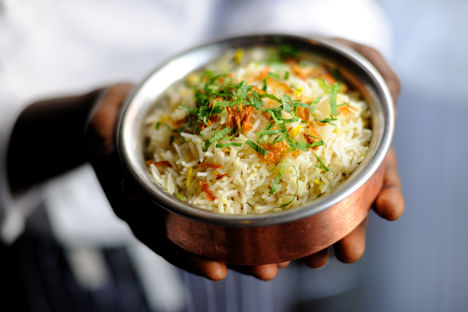
Indian Michelin star chefs
While Anglo-Indian food has been widely available for a long time, it was only relatively recently that refined Indian food was available in the UK. Debra Waters explores the top, Michelin-starred Indian chefs and their restaurants.
Indian Michelin star chefs
While Anglo-Indian food has been widely available for a long time, it was only relatively recently that refined Indian food was available in the UK. Debra Waters explores the top, Michelin-starred Indian chefs and their restaurants.
Until relatively recently, you’d struggle to find refined Indian food in the UK. Anglo-Indian fare was a law unto itself – not the complex, masterfully spiced cooking that exists in South Asia. Instead, it erred on the oily, heavy side with paving stone slabs of naan bread, more often than not used to soak up excessive beer consumption. This is not necessarily a bad thing; who doesn’t love a curry night? But it’s done little to assert the nuances – and diversity – of authentic Indian cuisine.
Whereas cooks such as Madhur Jaffrey showed us how to cook Indian at home, and there’s a busy curry house on every high street, high-end Indian restaurants were sorely lacking on British soil. When Vivek Singh, executive chef at the highly regarded Cinnamon Club, opened his restaurant in 2001 he wanted to challenge “people’s perception of Indian food.” Cyrus Todiwala of Café Spice Namasté fame, and an enduring presence on the Asian culinary scene, also recognised the public’s view of Indian food as “cheap and cheerful fodder”, but admitted that it’s changing.
Michelin recognition eluded Indian cuisine – then in 2001, at the age of 31, Indian chef Atul Kochhar won a star for Tamarind, in London’s Mayfair. In 2003, he opened Benares in Berkeley Square, which won a star in 2007. Kochhar combines his culinary heritage with British gastronomy, creating modern versions of originals from his motherland that have earned him many accolades.
Vineet Bhatia’s initial experience of Anglo-Indian cooking in the UK was galling. He concentrated on producing genuine but intriguing dishes and in 2001, Zaika, where he was head chef, was also awarded a Michelin star. Since 2006, Bhatia’s own establishment – Rasoi in Chelsea – has held a star; in 2009, Rasoi by Vineet in Geneva was also awarded one.
Rasoi is a sumptuously designed place reminiscent of a palace boudoir. Amidst the opulent surroundings diners experience unique flavour combinations. There is a global touch to Vineet’s exquisite inventions, yet he remains fiercely loyal to his roots. He calls it ‘evolving Indian’, an apt term for fusion dishes that include lemongrass crusted foie gras coins, goat’s cheese samosas and Stilton lamb tikki.
After the Daily Telegraph ranked Sriram Aylur as one of the Top 5 Chefs in India he came to London and, in 1999, opened Quilon, which was awarded a Michelin star in 2008 that is still held. Aylur’s focus is on south-west coastal Indian; his fish and seafood dishes evoke the beaches of Goa and Kerala. Deftly cooked, with a lightness of touch, the style – while approachable – is resolutely progressive.
Hailing from Chennai in south-east India, Alfred Prasad came to London in 1999 and worked at Veeraswamy before moving to Tamarind. He took over as head chef on Atul Kochhar’s departure in 2002, and has maintained the restaurant’s Michelin star since. In this sophisticated Mayfair restaurant, Prasad takes inspiration from traditional Moghul cuisine and cooks many of his dishes in a tandoor oven – a style indigenous to north-west India – alongside more contemporary creations. While Prasad’s food is big on aroma and flavour – typical of India – and quality ingredients are key, it’s descriptively understated and presented with a refinement for which he has won much praise.
Karunesh Khanna’s Amaya in Knightsbridge has held a Michelin star since 2006. Of all the Indian restaurants to have been bestowed with one, it’s arguably the most laidback. Essentially an Indian grill using three methods: tandoor, sigri and tawa, dishes come out tapas-style from the lively open kitchen – upscale plates and street food are prepared with equal respect. A place where you are encouraged to share and eat with your fingers may not sound particularly urbane yet Amaya maintains an air of glamour that makes it popular with critics and diners.
The newest Michelin-starred kid on the block is Trishna in Marylebone. The sister seafood restaurant to Trishna Mumbai, renowned for its king crab and celebrity patronage, Trishna UK is a more low-key affair that exudes finesse. Owner Karam Sethi was Head Chef at the time of Michelin star (he had previously worked at Trishna Mumbai and Zuma, London). The mouthwatering menu isn’t overwhelmingly lengthy either.
There is a handful of Michelin-starred Indian restaurants outside London - Junoon and Tulsi in New York are both respected, while Rasoi by Vineet in the Mandarin Oriental Hotel in Geneva has successfully furthered Bhatia’s reputation. There are none in India, though this is no reflection on the country’s quality of chefs, but because – while Michelin has a presence in Japan, China, Hong Kong – it’s not active there.
A Michelin star, or two, or three, is a notable achievement and as Indian gastronomy continues to build on the successes of the likes of Bhatia, Prasad and Aylur – by chefs who understand the intricacies of Indian food and who fuse contemporary expectations with classic flavour combinations and cooking styles – we will see more establishments awarded.
Meanwhile, buzzy café-style crowdpullers such as Dishoom and Imli Street should not be underestimated. It would be stretch to imply that the Indian-fusion on offer here is Michelin standard, but these eateries are, to the masses at least, as fundamental in helping to dispel the notion that Indian cuisine is just about chicken tikka masala and onion bhajis.


